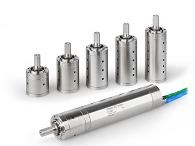
Posted to News on 22nd Jan 2021, 08:57
Can DC motors be used at high temperatures?
There is no need for a heated discussion about it as maxon's motor expert Andrew Gibson offers a view on the subject

Those familiar with DC motor catalogues and technical specifications will have noticed that there are often specified maximum ambient and winding temperatures for motors. In the case of our own products, the majority of DC motors have a maximum ambient temperature between 85Celsius and 100Celsius, and a maximum winding temperature between 100Celsius and 125Celsius and you may ask why this is.
Firstly, the difference between ambient temperature and the maximum winding temperature. Input supply is divided into Voltage (V) and Current (A). The voltage determines the speed, and the current determines the torque. When in use, the current will generate heat in the winding, so when a motor is specified for operation at high ambient temperatures, it cannot be worked as hard as if it was at regular workshop temperatures; otherwise, it will burn out.
What are the problems associated with heat?
Inside the motor is a magnetic circuit generated by the permanent magnet and the electromagnet, the motor winding. Both the permanent magnet and the winding are affected by heat. The Neodymium magnets start to demagnetise at around 160C, and they become weaker. Unfortunately, cooling the motor does not reverse the effect; it is a permanent degradation. The winding is encased in an insulating varnish which provides stability as well as insulation. As the temperatures increases above 160C the varnish softens, and the winding can deform, resulting in rubbing which wears away the insulation and causes a short circuit and motor failure. Very high-temperature increases can cause the varnish and insulation to melt, again resulting in a short circuit. The results are always the same; the motor is ruined.
High-temperature motors
Not surprisingly, there are environments where people want to use motors where the temperatures are higher, for example drilling into the Earth’s core for oil, gas or geothermal energy. Or perhaps on valve actuators on aircraft engines. For applications such as these we have a range of DC motors specially designed for such environments. For example our brushless HD (Heavy Duty) range can operate in ambient temperatures of up to 200Celsius with a maximum winding temperature of 240Celsius.
How do these motors operate in such high temperatures?
The magnets in the maxon HD motors are manufactured from Samarium Cobalt (SmCo). Samarium Cobalt rare earth magnets can reach much higher temperatures before they start to demagnetise. The copper wire used in the winding also has a higher temperature rated insulation. Finally, the impregnation varnish is rated to a much higher temperature which ensures that the winding remains stable throughout the operating temperature range.
Why not make all motors capable of reaching higher temperatures?
It is not an easy process to manufacture a high-temperature motor; the enhanced insulation on the copper wire is very rigid, which makes it much more difficult to wind. It also doesn’t work with all winding patterns. Another reason is cost, more specialist materials cost more and why would people want a more specialist higher price motor for an application where it isn’t needed.
In high volume applications we can upgrade our standard motors for projects where higher temperatures are needed, and due to the limited HD range there isn’t a motor to suit. If necessary we will investigate the feasibility of producing the winding and create a production size batch of windings to ensure there is a high enough yield from the wire. Finally, if the yield is sufficient, sample motors will be manufactured, and the technical specification validated.
What do you do when your application is pushing the ambient temperature boundaries?
Contact a technical expert such as the team we have here, and we will discuss key parameters for your application, for example looking at speed and torque at the output, what duty cycle the motor will see and what your input supply is. Then we’ll look at the environment, temperature, shock/ vibration elements too. We will also enquire about other restrictions, for example the space envelope and mass. Once we have collected all the data, we can start examining the possible options to provide a solution.
When there are high temperatures, we must carry out a thermal analysis to ensure the motor is not going to burn out in service. We analyse the speed and torque profile over the duty cycle based on the specific ambient temperature. Our in-house developed software gives us crucial information, including the winding temperature. Is it reaching or passing the maximum winding temperature? Is there enough time in the duty cycle to allow it to cool down? After multiple cycles, is it remaining below the maximum winding temperature?
Contact us if the heat is on with your motor selection.
Want the latest machine building news straight to your inbox? Become a MachineBuilding member for free today >>

















